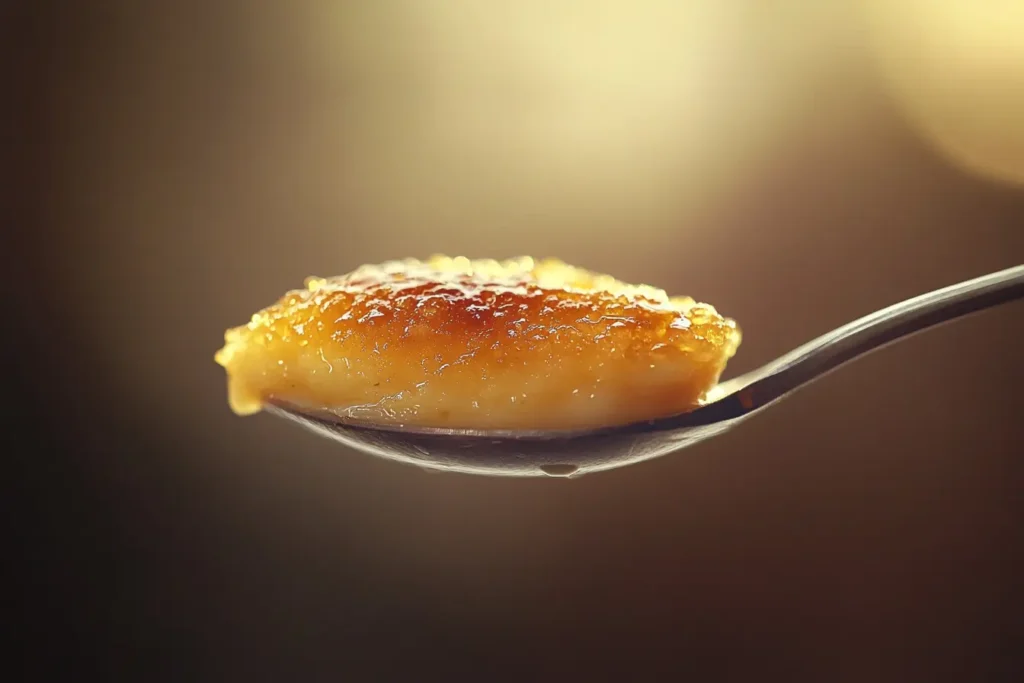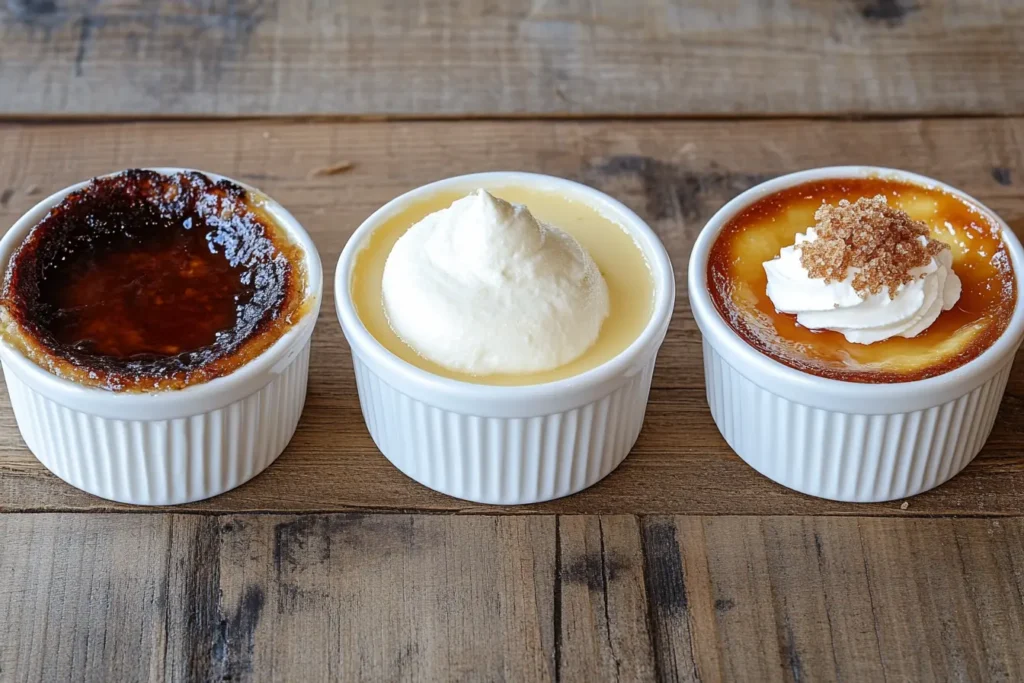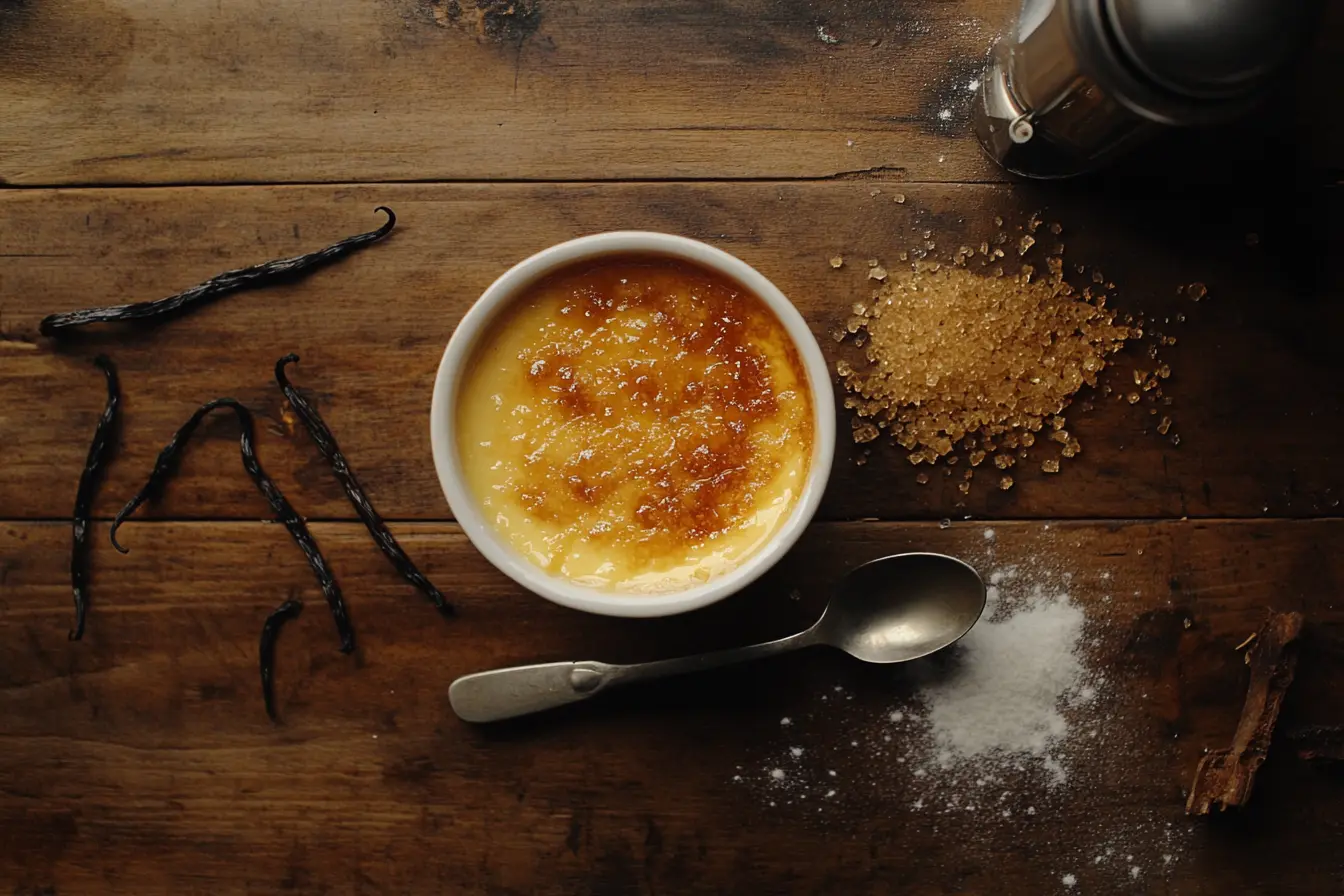What does crème brûlée taste like? If you’ve never tried this classic French dessert, you might be wondering about its flavor, texture, and what makes it so special. Crème brûlée is a rich, creamy custard with a crisp caramelized sugar topping, offering a perfect balance of sweetness and indulgence.
In this article, we’ll explore:
- The flavor profile of crème brûlée, from vanilla notes to caramelized sugar.
- The contrast between its smooth custard and crunchy top.
- Flavor variations and how different ingredients change its taste.
- How crème brûlée compares to other custard-based desserts.
Now, let’s dive into the origins and unique appeal of this decadent dessert!
Introduction to Crème Brûlée
The Origins of Crème Brûlée
Crème brûlée, which means “burnt cream” in French, dates back to 17th-century France. However, similar custard desserts existed in Spain (crema catalana) and England (Trinity cream) around the same time.
This dessert became iconic in French cuisine, with its signature crisp caramelized sugar layer setting it apart from other custards. Today, it’s a staple in fine dining restaurants and home kitchens alike.
What Makes Crème Brûlée Special?
Why do people love crème brûlée? It’s all about the contrast in textures and flavors:
- The rich, velvety custard melts in your mouth.
- The golden caramelized sugar crust adds a satisfying crunch.
- The balanced sweetness makes it decadent yet not overwhelming.
Whether served warm or chilled, its simple yet luxurious nature makes it an unforgettable treat.
The Flavor Profile of Crème Brûlée
The Classic Vanilla Flavor
What does crème brûlée taste like? At its core, crème brûlée has a rich, creamy, and lightly sweet flavor, with vanilla as the star ingredient. Traditional recipes use real vanilla beans or high-quality vanilla extract, giving the custard a deep, aromatic taste that isn’t overly sugary.
- Vanilla beans add a floral, warm depth that enhances the custard’s overall richness.
- Heavy cream and egg yolks provide a buttery, slightly caramelized flavor.
- The sweetness is subtle and well-balanced, making it sophisticated rather than overwhelming.
Because of its smooth, melt-in-your-mouth texture, crème brûlée tastes even more indulgent than regular custards.
Notes of Caramel and Custard
Another layer of flavor comes from its signature caramelized sugar topping. This thin, glass-like crust adds a delightful contrast to the soft custard below.
- Torched sugar creates a slightly smoky, burnt caramel taste.
- The deep amber color means the caramelization process enhances bitterness and complexity.
- This balance of sweet and bitter flavors is what makes crème brûlée stand out from other custards.
When you take a bite, the warm, crunchy sugar shatters under the spoon, revealing the cool, creamy custard underneath—a perfect contrast in texture and taste.

The Texture of Crème Brûlée
The Crunchy Sugar Crust
One of the best things about crème brûlée is its caramelized topping, which is torched or broiled to create a crisp, golden crust. This layer is what gives crème brûlée its satisfying crunch.
- The sugar melts and hardens into a delicate, crackable surface.
- The thickness of the sugar crust depends on how much sugar is sprinkled before torching.
- When done right, it should be evenly browned and shatter easily when tapped with a spoon.
This contrast between crispy and creamy is part of what makes crème brûlée so irresistible.
The Smooth, Creamy Custard
Beneath the caramelized sugar lies a silky-smooth custard that’s thicker than pudding but lighter than cheesecake. Achieving this perfect texture depends on:
- Slow baking in a water bath (bain-marie) to ensure even cooking.
- A high cream-to-egg ratio, making it luxuriously rich yet delicate.
- Proper chilling, which allows the custard to set while staying velvety and smooth.
When made correctly, crème brûlée should be firm enough to hold its shape yet soft enough to melt in your mouth. It’s this creamy, indulgent consistency that makes it a favorite in fine dining and home kitchens alike.
Variations in Crème Brûlée Flavors
Crème brûlée is known for its classic vanilla flavor, but chefs and home bakers have experimented with countless variations to create exciting new taste profiles. If you’re wondering, what does crème brûlée taste like?, the answer depends on the ingredients used.
Beyond Vanilla – Popular Flavor Variations
While traditional crème brûlée is flavored with vanilla beans and sugar, different ingredients can transform its taste:
- Chocolate Crème Brûlée: Rich and indulgent, this version replaces some cream with melted dark or milk chocolate for a silky, cocoa-infused custard.
- Coffee Crème Brûlée: Adding espresso or coffee extract creates a bold, slightly bitter contrast to the custard’s sweetness.
- Citrus Crème Brûlée: Infusing the cream with lemon, orange, or lime zest gives a bright, tangy twist to the classic recipe.
- Matcha Crème Brûlée: A Japanese-inspired variation that incorporates green tea powder, adding an earthy, slightly bitter note.
- Liqueur-Infused Crème Brûlée: Some recipes include Bailey’s, Grand Marnier, or Amaretto, giving the custard a sophisticated kick.
These variations show that crème brûlée can be customized to suit different palates, whether you prefer rich, fruity, or aromatic flavors.
How Different Sugars Impact Taste
Another factor that affects what crème brûlée tastes like is the type of sugar used for caramelization:
- White Sugar: Creates a clean, crisp caramel layer with a classic burnt sugar flavor.
- Brown Sugar: Adds deeper caramel and molasses notes, making it slightly richer and bolder.
- Turbinado or Demerara Sugar: Produces a thicker, crunchier crust with a hint of toffee-like sweetness.
Caramelization time also influences the final taste—a lightly torched topping will be sweet and mild, while a darker caramelization brings out bitter, smoky notes.
How Crème Brûlée Compares to Similar Desserts
Many people wonder, what does crème brûlée taste like compared to other custard-based desserts. While it shares similarities with flan, pudding, and other creamy treats, there are key differences in taste and texture.
Crème Brûlée vs. Flan
Flan and crème brûlée both feature a creamy, egg-based custard, but they differ in texture and presentation:
- Crème Brûlée:
- Topped with a hard, caramelized sugar crust.
- Has a richer, denser consistency due to heavy cream.
- Eaten directly from the ramekin without flipping.
- Flan:
- Features a soft caramel sauce, rather than a crunchy sugar topping.
- Typically made with milk instead of heavy cream, resulting in a lighter texture.
- Served upside down, allowing the caramel to coat the custard.
In short, crème brûlée has a crunchier, richer texture, while flan is softer and lighter.
Crème Brûlée vs. Pudding and Custard
Although pudding and crème brûlée both have a creamy base, their ingredients and preparation methods create major differences:
- Pudding: Uses cornstarch or gelatin as a thickener, making it softer and more spoonable.
- Custard: Often stirred instead of baked, resulting in a looser consistency.
- Crème Brûlée: Always baked and chilled, giving it a firm yet creamy texture.
Compared to pudding and custard, crème brûlée is richer and more indulgent, with a distinctive caramelized crunch that sets it apart.

FAQs – What People Also Ask
If you’re still wondering, what does crème brûlée taste like?, you’re not alone! Many people have questions about its flavor, sweetness, and texture before trying it. Let’s clear up some of the most common queries.
Does Crème Brûlée Taste Like Pudding?
Yes and no. Crème brûlée and pudding share a creamy texture, but they taste quite different:
- Pudding is thickened with cornstarch or gelatin, making it softer and less rich.
- Crème brûlée has a denser, silkier consistency because it’s made with egg yolks and heavy cream.
- The caramelized sugar topping adds a crunchy contrast that pudding lacks.
While both are smooth and sweet, crème brûlée has a more luxurious, velvety mouthfeel.
Is Crème Brûlée Overly Sweet?
No, crème brûlée is not overly sugary. Instead, it has a delicate balance of sweetness, richness, and caramelized depth:
- The custard base is mildly sweet, enhanced by vanilla and cream.
- The burnt sugar topping adds a slight bitterness, balancing the overall flavor.
- It’s not as sweet as frosting or cake, making it perfect for those who enjoy sophisticated desserts.
If you prefer less sweetness, variations like coffee or dark chocolate crème brûlée can add a bolder, less sugary taste.
What Does the Burnt Sugar Taste Like?
The torched sugar crust is what makes crème brûlée unique. It adds a:
- Crispy texture that cracks under your spoon.
- Rich caramel flavor, ranging from light and buttery to dark and smoky.
- Subtle bitterness when deeply caramelized, similar to toffee or roasted nuts.
This contrast between sweet custard and crisp, slightly burnt sugar is what makes crème brûlée so special.
Does Crème Brûlée Have an Eggy Taste?
A well-made crème brûlée shouldn’t taste eggy. However, if it’s overcooked, the eggs can curdle and develop a strong, eggy flavor. The perfect crème brûlée should have:
- A smooth, custard-like taste, with no overpowering egg flavor.
- A rich vanilla aroma, complemented by cream and caramelized sugar.
- A delicate balance of sweetness, creaminess, and texture.
If your crème brûlée tastes too eggy, it was likely baked at too high a temperature or cooked for too long.
Final Thoughts – A Dessert Worth Trying
So, what does crème brûlée taste like? In short, it’s a rich, creamy custard with a crisp, caramelized sugar topping, offering a perfect balance of sweetness and texture.
Why Crème Brûlée Stands Out
- The smooth, velvety custard is incredibly indulgent.
- The caramelized sugar crust provides a delicious contrast.
- Its subtle sweetness and deep vanilla flavor make it sophisticated yet comforting.
- There are countless variations, from chocolate and coffee to citrus and matcha.
Should You Try Crème Brûlée?
Absolutely! Whether you’re a dessert lover or just curious, crème brûlée is:
- Elegant yet easy to enjoy.
- Not too sweet, not too heavy—just right.
- A perfect mix of creamy and crunchy textures.
If you haven’t tried it yet, crème brûlée is a must for any dessert fan. Once you experience that first satisfying crack of caramelized sugar, you’ll understand why it’s a timeless favorite.

